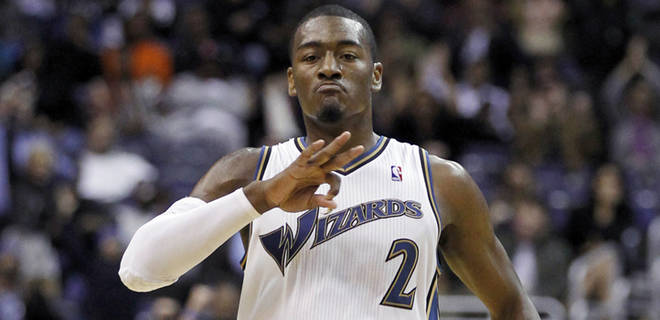The summer of 2009 was a different time. Cleveland Cavs fans were still “Witnesses”, Lebron James had not yet moved into “Witness Protection” between Wade and Chris Bosh in Miami, Michael Vick was still in prison and Ricky Rubio, the Spanish Harry Potter, was set to become an actual Wizard in D.C.
However, the Washington Wizards thought a combination of veteran perimeter players including Minnesota’s Mike Miller and Randy Foye were a better mix than the potential addition of Spanish phenom Ricky Rubio. It’s okay. Finish laughing before jumping to the next paragraph.
The next year, however, the Wizards were redeemed with the No. 1 overall pick in the 2010 Draft. With that pick, they selected John Wall. Wall’s rookie year was a yearlong highlight reel that flashed his explosiveness, his baseline-to-baseline speed as well as his awe-inspiring potential. However, it also featured a glimpse into his flaws. Wall turns the ball over at a remarkable rate and for the second straight year is second in the league in turnovers per game.
Like Oklahoma City’s Russell Westbrook Wall will be dogged with questions about whether he is a true point guard until he can win a title or change positions. For now, he is one of the Wizards few scoring options which means he’s had to sacrifice his development as a point guard so the team can pile up a few meaningless wins in this lost season.
Score-first point guards are the scrambling quarterbacks of the NBA. Pass first guys are the pocket throwers. Wall and Rubio are an intriguing dichotomy at point guard. Like Fat Joe and Trey Songz, George W. and Obama or Mike Vick and Drew Brees, Wall is the non-traditional point guard that relies on his athleticism but is unselfish. Rubio is a facilitator first and foremost who makes unconventional plays courtesy of his uncanny vision.
Wall’s second year has been a disaster. Not only has he struggled mightily shooting the ball but rookie point guards Ricky Rubio and Kyrie Irving have stolen the limelight and their teams are in the playoff hunt while Wall’s Wizards scrape the bottom of the standings.
Wall’s past three games have been a microcosm of his sophomore slump. Friday night against the Indiana Pacers, the Wizards trailed by two with 9.5 seconds remaining when Wall received the inbounds pass near his own three-point line. Wall proceeded to dart in and out of the paint searching for a lane to the basket before finally barreling down the middle and swishing a runner from 17 feet away. Unfortunately, the shot was released after the buzzer sounded.
It was almost as bad as his last high school game with Word of God Academy. While dribbling out the clock in the waning seconds of North Carolina’s 1A State Championship Game, Wall carelessly bounced the ball off the back of his foot with 25 seconds remaining. Word of God lost the game on a buzzer beater at the end of regulation. Ironically, that shot should not have counted. It was just an example of the lapses in his instincts as a point guard.
On Saturday against the Atlanta Hawks, Wall shot just 1 for 10 from the field and finished with eight points and three assists and followed that up with a 5 for 17, 12 point, nine assist performance against the Celtics.
Meanwhile, before his ACL injury Rubio exhibited Magic Johnson-like flair and displayed arguably the best court vision in the league. Rubio resembled Thomas Edison with inventive ways he discovered to slip the ball through passing lanes (or through Derek Fisher’s legs). His telepathic anticipation skills give the impression that he plays with a crystal ball instead of a regulation Spalding. Because of Rubio’s style of play there’s no reason to believe he can’t return from his injury as the same player.
The question should be asked though. Would the franchise have been better off by taking Rubio fifth overall in 2009? Had the Wizards begun their rebuilding plan one year sooner, they would have begun the 2011-12 season with a fantastic starting backcourt of Rubio and Wall. Wall’s dribble drive skills make him a better fit as a combo guard and give him more in common with Dwyane Wade and Westbrook than Rubio or Irving.
He’s the same height as Wade, struggles shooting from behind the arc and has an instinct for blocking shots from the guard position. Comparing 2006 Finals MVP Wade to Wall may seem like blasphemy but when Wade was Wall’s age he was still busy leading Marquette to the Final Four.
The alternative theory is that Wall is a mirror version of Westbrook without the stability of Durant, James Harden and Serge Ibaka. It makes sense. At Kentucky, Wall shared ball-handling duties with the Clippers’ Eric Bledsoe. At UCLA, Darren Collison ran the point instead of Westbrook. Many still believe that the acquisition of a point guard like Nash would allow Westbrook to flourish in the starting lineup and end the Durant-Westbrook bickering.
Conversely, Wall was acclimated to the pro game under the tutelage of The Three Stooges Gilbert Arenas (Curly), Javale McGee (Moe) and Andray Blatche (Larry). Rubio had the benefit of playing alongside the NBA’s premier power forward in Kevin Love, the No. 2 pick in last years draft Derrick Williams and a slew of other rising young talents.
Rubio and Wall’s style differences are most apparent in how they score. Wall makes his living in the lane and scoring at the rim. Wall currently leads all NBA point guards in free throws attempted and attempts more per game than Derrick Rose and Westbrook.
According to advanced stats from HoopData, through 48 games, Wall has scored on 167 of his 269 attempts at the rim. In 41 games, Rubio scored at the rim on 48 of his 102 attempts.
Jump shooting is where the concern lies. Wall is just 89 for 271(32%) from 10-23 feet while Rubio hit 48 of 143(39%) from the same distance. Wall has hit 2 of 27 this season. While Wall is shooting 7.4 percent of his three-point attempts, Rubio was a respectable 32 of 94 (34%) from downtown this season.
From the above numbers, it’s apparent that Wall looks for his shot more often than Rubio but still struggles more than Rubio whose shooting ability was questioned incessantly last year while he was still in Spain averaging 1.6 points through seven games in international competition. Rubio also lost his starting spot for FC Barcelona after shooting 39 percent from the field and 23 percent from three-point range.
In the assists department Rubio holds a slight advantage over Wall. Rubio averaged 9.6 assists and 3.7 turnovers per 40 minutes right out of the gates. Wall dishes 8.6 assists and 4.4 turnovers per 40. Despite concerns about Rubio’s defense he also averages nearly a steal more than Wall per game.
The hope was that adding a low post scorer like Nene would help Wall. In the first four games since the Wizards traded Alley oop receiver Javale McGee and Nick Young, and introduced Nene to the rotation, Wall is averaging 12 points, 7.2 assists and shooting 36 percent.
Comparing Wall to Westbrook gives you a better idea of his potential. Statistically Westbrook was ahead of Wall’s development in his second year. Westbrook attacked the rim slightly more often and averaged 9.3 assists per 40 but he also struggled shooting from downtown (22%). The upside for Wall is that in year three, Westbrook improved dramatically as do most point guards at some point. Hopefully for Wall it’s just a matter of when.
Wall’s major problem right now is that he can create but he can’t shoot. If the Wizards eventually pair a second legit All-Star scorer with Wall it will be interesting to see whether they will be able to co-exist.
Rubio and Wall could have done great things together but that duo will only exist in dreams and maybe future All-Star Games. However, it will be interesting to see how they develop as two very different point guards and who wins more games long term. Wizards fans will be watching closer than most.



